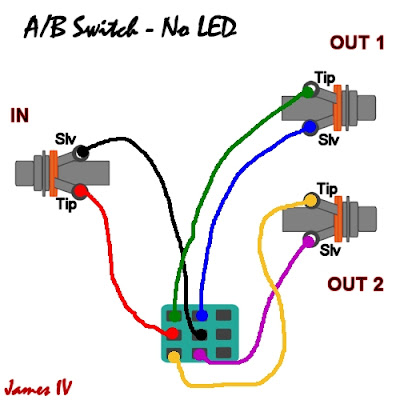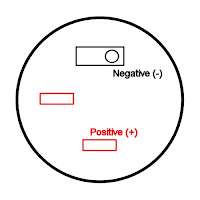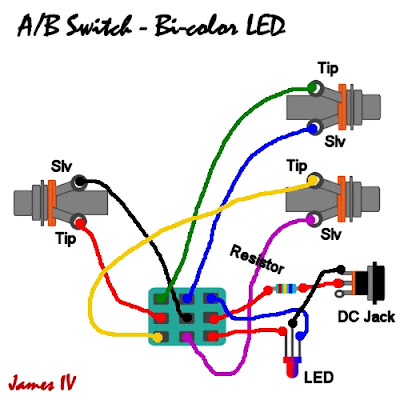Parts needed:
3x Mono 1/4" Jacks
1x 3PDT Latching Footswitch (Or a DPDT. Either will work)
This is the simplest type of A/B switch. Some people wire the sleeves (Slv on the diagram) together in a chain and then to the switch, but I do it differently, wiring them all to separate lugs on the footswitch, to keep the grounds isolated for noise efficiency purposes.
----------
Parts Needed:
3x Mono 1/4" Jacks
1x 3PDT Latching Footswitch
2x LEDs
2x LED Bezels (Optional)
1x DC Jack
1x 1/4 watt resistor
Mount the parts in your enclosure and then solder everything as shown on the diagram. To mount the LEDs, you can either use LED bezels, or drill holes for them the same size as the LED (most likely 5mm or 3mm) and push the LED up into from the inside of the enclosure. If you aren't using bezels and the LED isn't staying in the hole, you can hold it in place with a bit of glue.
For the resistor, the standard value is 4.7K. If you want the lights to be brighter though, use a lower value resistor such as 2.2K.
When wiring the DC jack, use the diagram below. The positive is wired to the resistor, which is then wired to the longer leg of the LEDs, and the negative is wired directly to the footswitch.
----------
Parts Needed:
3x Mono 1/4" Jacks
1x 3PDT Latching Footswitch
1x Bi-color LED
1x LED Bezel (optional)
1x DC Jack
1x 1/4 watt resistor
This version is pretty much the same as the previous one, but it has the benefit of using a single LED which changes colors, based on whichever output is active.
The LED is wired a little differently here. The positive of the DC jack is wired to the resistor, which is then wired to the middle lug on the third row of the footswitch. The middle prong of the LED is wired to the ground on the DC jack, and the remaining two prongs are wired to the footswitch.




Comments
Post a Comment